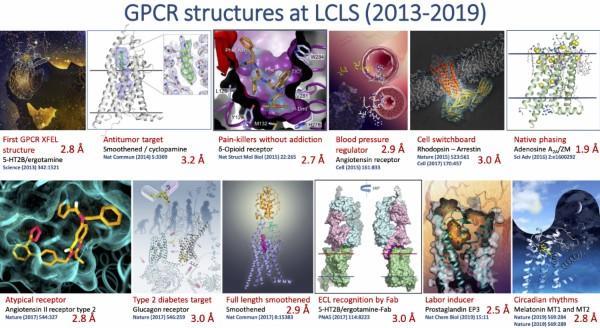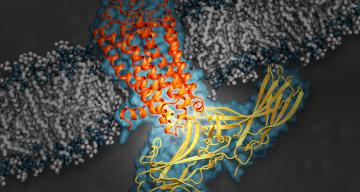Membrane Proteins
Understanding membrane proteins
Membrane proteins are a broad class of proteins that often work as molecular machines. These “machines” perform diverse functions, such as ion transport or signal transduction, by undergoing structural rearrangements. Crystallography is used to provide a better understanding of how these proteins function.
Extremely bright light sources, such as the Linac Coherent Light Source (LCLS), make it possible to capture time-resolved molecular snapshots of these proteins at different time points in their functional cycle. The structural changes can then be related to their biological function.

Current issues to overcome
Membrane proteins are often difficult to crystallize. Even if the crystallization conditions of the protein are known, it can be almost impossible to grow large, well-ordered crystals. The resulting membrane protein microcrystals can sometimes be difficult to study at the synchrotron, because of the limited brightness of the light source.
Moreover, microcrystals of membrane proteins tend to be more prone to X-ray radiation damage than large crystals grown from soluble proteins. Typically, when using synchrotrons, cryogenic temperatures are used to mitigate radiation damage. However, imaging the samples at non-native temperatures can induce non-native conformations in amino acid side chains.
How LCLS can help
Fortunately, X-ray free-election lasers (XFELs) like the Linac Coherent Light Source (LCLS) have largely solved these problems by allowing the study of proteins at near-native conditions (room temperature), and the ability to use small crystals (<10 µm). This opens new opportunities for studying the dynamics, kinetics, and function of membrane proteins. G-Protein Coupled Receptors (GPCRs) have been the flagship for showing how XFELs can help research into membrane proteins.

Latest publications
The following publications highlight how membrane proteins have been studied at LCLS:
- Liu et al. (2021) Molecular basis for lipid recognition by the prostaglandin D2 receptor CRTH2. Proc Natl Acad Sci USA 118: e2102813118.
- Stauch et al. (2019) Structural insights into melatonin receptors. FEBS J 287 1496-1510.
- Luginina et al. (2019) Structure-based mechanism of cysteinyl leukotriene receptor inhibition by antiasthmatic drugs. Sci Adv 5: eaax2518.
- Johansson et al. (2019) XFEL structures of the human MT2 melatonin receptor reveal the basis of subtype selectivity. Nature 569: 289-292.
- Stauch et al. (2019) Structural basis of ligand recognition at the human MT1 melatonin receptor. Nature 569: 284-288.
- Yun et al. (2021) Early-stage dynamics of chloride ion–pumping rhodopsin revealed by a femtosecond X-ray laser. Proc Natl Acad Sci USA 118: e2020486118.
- Nass-Kovacs et al. (2019) Three-dimensional view of ultrafast dynamics in photoexcited bacteriorhodopsin. Nat Comm 10: 3177.
- Dods et al. (2021) Ultrafast structural changes within a photosynthetic reaction centre. Nature 589: 310-314.
- Fransson et al. (2021) Effects of x-ray free-electron laser pulse intensity on the Mn Kβ1,3 x-ray emission spectrum in photosystem II—A case study for metalloprotein crystals and solutions. Struc Dyn 8: 064302.
- Hussein et al. (2021) Structural dynamics in the water and proton channels of photosystem II during the S2 to S3 transition. Nat Comm 12: 6531.
- Keable et al. (2021) Room temperature XFEL crystallography reveals asymmetry in the vicinity of the two phylloquinones in photosystem I. Sci Rep 11: 21787.
- Ibrahim et al. (2020) Untangling the sequence of events during the S2 → S3 transition in photosystem II and implications for the water oxidation mechanism. Proc Natl Acad Sci USA 117: 12624.
- Clairfeuille et al. (2020) Structure of the essential inner membrane lipopolysaccharide–PbgA complex. Nature 584: 479-483.

